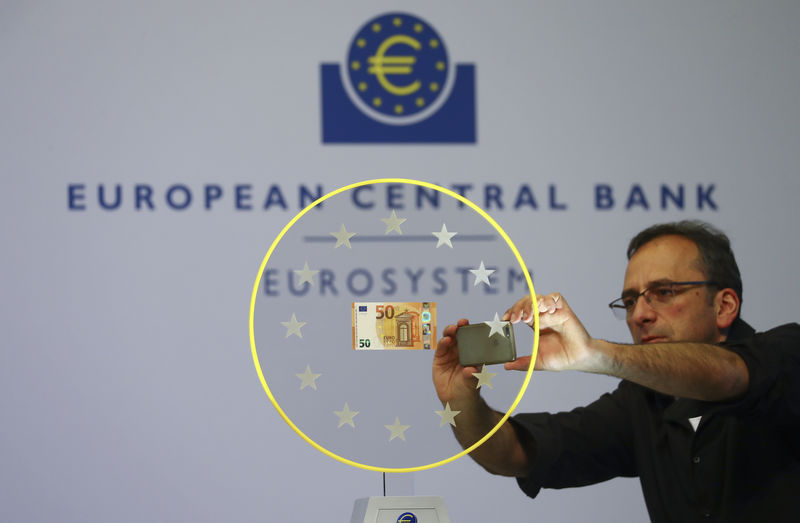By Dhara Ranasinghe
LONDON (Reuters) - The pool of negative-yielding euro zone bonds is draining at last as extreme economic pessimism gripping markets abates, but sub-zero borrowing costs are expected to remain a persistent feature of the year ahead.
Investors attending this week's Reuters Global Investment Summit said that even after a recent bond selloff, the pile of negative-yielding bonds would likely stay sizeable given weak inflation, structural long-term demand for government debt and expectations for European Central Bank rates to stay below 0%.
The stock of euro zone government bonds with a negative yield on Tradeweb ballooned to around 5.61 trillion euros ($6.2 trln), or almost 69% of the total market, in August. It has since eased to around 5 trillion euros or 62%, according to data from the electronic trading platform.
Globally, the pile of negative-yield bonds including corporate debt has shrunk to around $12.5 trillion from a record high around $17 trillion just two months ago.
A stabilization in data, confidence that a no-deal Brexit can be avoided, optimism on U.S./China trade talks and a sense that major central banks are unlikely to ease policy further have all taken the edge off a stunning bond market rally.
Graphic: Citi Economic Surprise Index, https://fingfx.thomsonreuters.com/gfx/mkt/12/8301/8232/surprise%20index0611.png
Indeed, this week France's 10-year bond yield turned positive for the first time since July (FR10YT=RR) and the entire yield curve in Germany -- the euro zone's benchmark issuer -- is no longer negative as it was a month ago.
But for many bond investors, it is still early days.
"It's very short, you're still not even back at the level yields were at the summer," said Peter Fitzgerald, head of multi-asset management at Aviva (LON:AV) Investors, referring to the recent bond selloff.
"And yields can only go so far when you have interest rates negative in some of the key economies in the world," he told the Reuters Summit.
Graphic: Negative-yielding bonds in the eurozone, https://fingfx.thomsonreuters.com/gfx/mkt/12/8349/8278/negativeyield0711.png
The ECB cut its deposit rate to -0.50% in September and while further cuts are not anticipated in the coming year, neither are hikes.
That policy has hurt banks and stoked criticism from countries where saving is strong such as Germany and the Netherlands.
Commerzbank (DE:CBKG) said on Thursday that even the ECB's decision to implement a tiered interest rate last month would not fully offset the negative effects of its monetary policy.
"If the ECB due to a total new leadership tries to get away from negative rates, this would be the biggest surprise," said Georg Schuh, CIO for EMEA at German asset management firm DWS.
Schuh told the Summit there is a one-in-four chance new ECB chief Christine Lagarde will deliver a rate hike in her first year in office.
Only such a prospect or a big fiscal stimulus package from Germany, Europe's biggest economy, could spark a bigger selloff in euro zone debt markets, investors said.
For sure, after a near four-decade bull market in government bonds, caution in calling a turnaround prevailed.
"We're starting 2020 as a new era here, you would think the danger is not very big because there's no inflation threat to speak of today, the economy’s not going to rebound magically overnight," said Didier Saint-Georges, managing director at Carmignac.
"Therefore the upside risk on yields is quite limited, except that you’re starting from such a low level that it doesn’t take a big absolute move in yields to make a huge difference to prices."
Germany's benchmark 10-year Bund yield has risen roughly 40 basis points to -0.30% from record lows hit in August.
"We're cognisant that with yields being where they are, the value is clearly not as obvious as it was before," said Ross Hutchison, a fixed-income fund manager at Aberdeen Standard Investments. His bias was still for low yields, given elevated risks globally.
"I would want to see a more significant rise in bond yields before getting more bearish on the asset class," added M&G Investments' Jim Leaviss, who authors the widely read Bond Vigilante blog.
Graphic: Govt bond market returns 2019, https://fingfx.thomsonreuters.com/gfx/mkt/12/8302/8233/Returns0611.png
